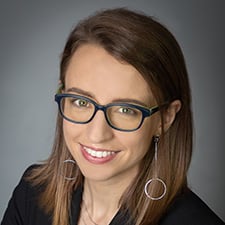Most medical students today probably cannot recall a time when it was legal to smoke on passenger airlines in the U.S. Still, it wasn’t so long ago that the federal government allowed some passengers and even crew to light up in the air. The total ban on smoking on domestic and international flights didn’t take effect until the summer of 2000.
Medical students might be equally surprised to learn that some of the credit for this historic legislation goes to an earlier generation of medical students. That’s because the AMA policy urging the ban, which lent professional credibility and scientific heft to the national effort to clear the air on this public health issue, grew out of a resolution first put forward by none other than the AMA Medical Student Section (AMA-MSS), the Association’s representative body for student needs and priorities, in the early 1980s.
Some 40 years after that breakthrough, and on its 50th anniversary, the AMA Medical Student Section’s remit is largely the same—to be medical students’ voice within the AMA for improving medical education, protecting patients and advocating on the future of medicine.
“As students, we have expertise in some areas, but the big thing is that we’re not jaded—we’re hopeful,” said Anna Heffron, MD, PhD, who graduated this month from the University of Wisconsin School of Medicine and Public Health. Dr. Heffron is the section delegate for the AMA-MSS. Among other responsibilities, she coordinates the students representatives’ advocacy efforts on resolutions at the biannual meetings of the AMA House of Delegates, the legislative and policymaking body of the AMA.
Medical students “also feel some urgency because we're walking into the field and seeing things with fresh eyes,” said Dr. Heffron, who has helped pass AMA policy on racism as a public health threat, policing reform and racial essentialism. “We see things about the profession that are problematic, including how it harms our families and our patients. But we come in thinking, ‘We can change things. This can be fixed.’”
Wait, what is a resolution?
With more than 50,000 members from nearly every medical school in the country, the AMA Medical Student Section is a platform for all U.S. medical students to voice their opinions on issues that matter to them as future physicians. Over the years, members of AMA-MSS have submitted more than 1,500 resolutions at AMA meetings to improve medical education and health care.
Resolutions are specifically formatted proposals asking the AMA to take a position or an action. According to the section’s resolution-writing guide—“We make it so that anybody can learn to write policy,” Dr. Heffron noted—they can be thought of as:
- The currency used to discuss ideas and establish policy that guides the actions of the AMA and other health care groups.
- A way to provide a democratic structure for a large, diverse organization to reach consensus on important issues.
- A tool to empower individuals or groups within the AMA to drive actions of the entire organization.
Of course, not all resolutions end up getting adopted as AMA policy, but recent successes include those mentioned above and others aimed at strengthening standards for LGBTQ+ medical education, changing the USMLE Step 1 exam to pass-fail and canceling the USMLE Step 2 CS exam.
Cue the “Schoolhouse Rock” song
How a resolution becomes AMA policy is much like how a bill becomes a law. There’s a rigorous review process that each Medical Student Section resolution undergoes before it can even be voted on by the AMA House of Delegates.
First, an AMA-MSS member identifies a problem and a solution to it, making sure the issue falls within the scope of the AMA and MSS. But the official first step is posting these initial thoughts on the AMA-MSS online Open Forum, which enables students to connect and collaborate with section members nationwide.
At this point, the AMA-MSS member drafts the resolution and gets feedback from a variety of AMA-MSS leaders. Modified resolutions then go through a number of steps to ensure they fit the established format, aren’t duplicative of previous efforts and achieve a score making them worthy of consideration by the AMA House of Delegates.
If a resolution makes it this far, it is assigned to a reference committee appointed for the meeting. The job of this committee is to read all the resolutions, along with testimony and staff notes, and then make recommendations on what actions the AMA-MSS should take. The potential recommendations are: adopt; adopt as amended; refer for study; not adopt; or reaffirm, the last of which means there is existing policy that covers the resolution’s requests.
The resolution then goes to a vote by the AMA-MSS Assembly. If it is approved, the next step is consideration by the AMA House of Delegates, where it will be assigned to the most relevant reference committee.
Delegates representing more than 170 state and specialty medical societies have the opportunity to discuss the resolution and offer testimony before the reference committees, which will then recommend one of the options outlined above. The final stop is the floor of the AMA House of Delegates, where a resolution must earn 50.1% of votes from the voting delegates to become AMA policy.
Adopted policies then drive the AMA’s advocacy efforts.
Policymaking isn’t always slow
Some resolutions take years to get adopted, but others are written and approved in the span of a single meeting. As a case in point, when the Medical Student Section gathered at the November 2019 AMA Interim Meeting, the Trump administration had recently directed the departments of Justice and Homeland Security to collect DNA, without consent, from incoming immigrants.
“We thought that was ethically irresponsible and the AMA should be against it,” said Tristan Mackey, MD, who graduated this year from the University of South Carolina School of Medicine Greenville and is section alternate delegate for the AMA-MSS.
“We started out by writing a letter to the AMA Board of Trustees and having our representative on the board elevate the issue,” said Dr. Mackey, who recently worked on passing policy on health care payment for undocumented persons, the quality of school lunch programs and evaluation of DACA-eligible medical students, residents and physicians. Then, “we introduced an emergency resolution at our Medical Student Section meeting asking the AMA” to take action because “the comment period was coming to a close.”
The resolution cleared the AMA-MSS and was immediately forwarded to the House of Delegates, where it was adopted right away.
“Soon after, a letter from the AMA was sent to the secretaries of the Department of Justice and Department of Homeland Security detailing why we thought that rule was wrong, and the final rule never went into effect,” Mackey said. “It was an example of how medical students can have an immediate effect on national policymaking.” Read the AMA’s letter (PDF).
Learn more about leadership opportunities for medical students.
It’s never too early to lead
Dr. Heffron will begin her residency training in emergency medicine at Icahn School of Medicine at Mount Sinai, in New York City, and Dr. Mackey will start his training in neurosurgery at University of Illinois College of Medicine Peoria.
Thanks to involvement in AMA-MSS, “I have friends all over the country,” Dr. Mackey said, noting that besides giving medical students access to national policy discussions, participating in the AMA Medical Student Section fosters leadership skills.
“I see M1s typing up their testimony and reading it word for word off of a script, and I remember doing that,” he said. “I'm at the point now where I can get up and just talk extemporaneously about an issue and make it personal. It reminds me every day why I got involved in medicine.”
AMA-MSS is one of a dozen member groups in the AMA. To find your medical school’s chapter of the AMA Medical Student Section or connect with members near you, email AMA-MSS.





